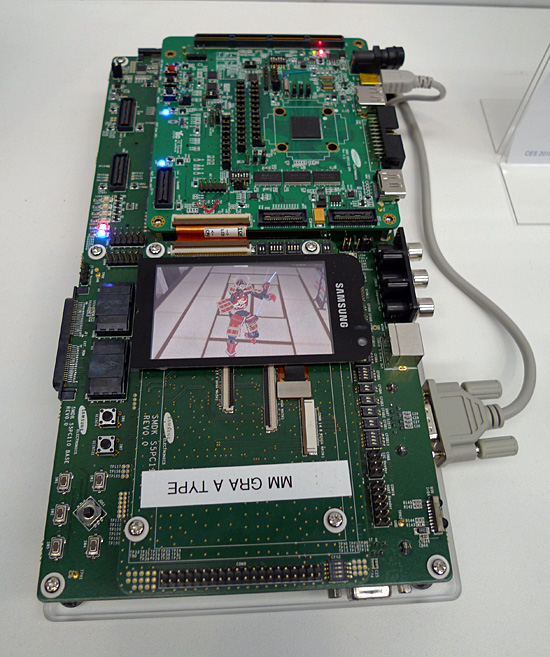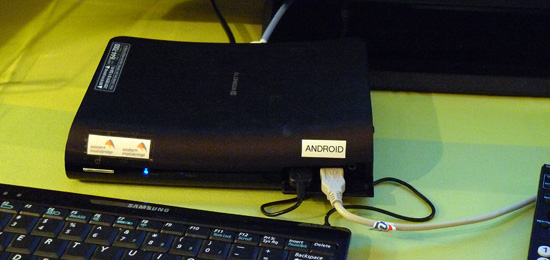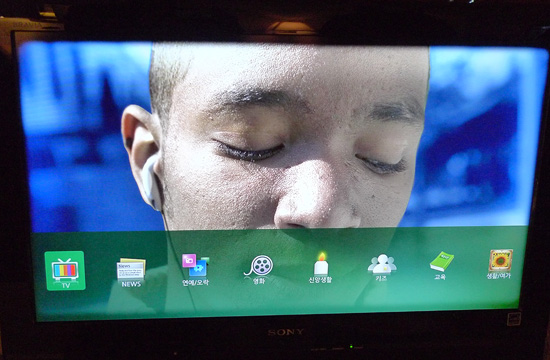The CES 2010 Conclusion - SoCs, Motherboards, Cases & More
by Anand Lal Shimpi on January 9, 2010 5:44 PM EST- Posted in
- Trade Shows
Imagination Technologies - Faster GPUs for SoCs
I met with Imagination Technologies, the makers of the GPU in everything from the iPhone 3GS to the Motorola Droid. They were showing off a 1.1GHz Samsung Cortex A8 SoC with an integrated PowerVR SGX 540:

The demo isn't anything impressive, but the GPU should be in the Tegra 2 class of performance. Definitely higher than what's in the iPhone 3GS and Palm Pre today. The PowerVR SGX 540 is what is being used in TI's Cortex A9 SoCs, which appear to be the direct competitor to NVIDIA's Tegra 2. I spoke with Samsung about their 1.1GHz A8 SoC (now running at 1.2GHz actually), but I wasn't able to get a firm date on when we can expect A9 based silicon from them.

Our friends at Imagination put together a tech demo of a 3D user interface for TVs running on Intel's CE4100 SoC. The CE4100 was announced back at IDF and integrates an Atom core with PowerVR SGX graphics. Imagation believes that TVs or set-top boxes with chips like the CE4100 will use the GPU in a similar capacity to smartphones: for fancy UIs.

MIPS, another SoC vendor that does a large amount of business in the set-top box market showed off a number of Android devices for the home. Many of these were set-top boxes running Android that could do everything from video playback to watching over-the-air TV:

Unfortunately most cable providers in the US aren't as receptive to devices that can enable content consumption from sources other than cable TV, and thus I wouldn't expect to see much support for technology like this in the US just yet. MIPS has found the best success in Asia for these types of STBs so far.










40 Comments
View All Comments
GeorgeH - Monday, January 11, 2010 - link
@JW:While I agree with you that the new IGP is impressive for an Intel product, cheering it on is a little bit like cheering on a paraplegic’s first bunt while other players are busy hitting home runs.
In the past when there were other options I would have been less critical, but now that it’s Intel’s IGP’s and chipsets or nothing things become more serious. I’m worried that Intel is going to only provide “adequate” solutions, bumping up performance and features simply to match competitors when they get too far ahead instead of significantly advancing the market all by themselves. As an example, when is there going to be an Intel chipset with SATA 6gbps or USB 3.0? When is their IGP going to get DX11?
I realize that for the foreseeable future discrete will always be the best way to go, but with so much of the market only using IGPs their performance will always limit and delay what gets developed for the rest of us. I’m not talking about games so much as things like Microsoft’s Aero interface and sweet little Mini-ITX HTPC platforms (maybe not be the best examples, but they should illustrate the point.)
As an aside, I did catch the links. I always value Anand’s (and AnandTech’s) opinions on what is significant and impressive even if I don’t agree with you – otherwise I wouldn’t be here. ;)
JarredWalton - Tuesday, January 12, 2010 - link
Really it's a balancing act in many ways. More transistors means more power, so you don't want every graphics chip out there to ship with 128 SPs/Stream Processors/Pipelines. Ideally, you'd make it so you can totally shut down the unneeded parts of the chip, but even so... what do you do if you want to make an ultraportable laptop and the power envelope is 15W for the CPU and GPU? You need a chip that will never use more than that amount of power (i.e. generate more than that amount of heat).So the way I see it, while we will continue to see improvements to IGPs over the coming years, they will never be a replacement for discrete GPUs. We're now at the point where they're able to do just about everything we need, such as H.264 video decoding, 2560x1600 output, etc. We could get 12-bit color processing and two dual-link capable outputs (or HDMI 1.4), but for gaming we'll always want a discrete GPU.
Which brings us to the final point: now that we have ATI and NVIDIA both supporting GPU switching so you can turn the discrete GPU on and off, the IGP should be viewed more as a power saving solution than a performance part. You want battery life and low power, you use the IGP (whether it's Intel or someone else); when you want 3D performance, you enable the discrete GPU.
Now the only thing I really need from Intel is Arrandale ULV... and drivers that work in every situation (i.e. all games where the hardware meets the requirements run without crashing, utilities like DXVA Checker don't fail, and that sort of thing).
lopri - Monday, January 11, 2010 - link
Thank you for the clarification. Yeah I thought GMA couldn't possibly an exciting subject even for Anand, its technical prowess (or the lack thereof) notwithstanding. I couldn't even 'give away' a G35 based system to a neighbor's kid due to the fear of possible embarrassment.No complaint on improvement, but I have a couple of questions on the new Intel HD Graphics:
1) Does 2560x1600 work?
2) Dual displays?
Normally I wouldn't expect such things on GMA, but I thought I saw these being 'advertised' by Intel. I haven't seen any review verifying them. I'd much appreciate if you could tell me how/whether these work.
semo - Monday, January 11, 2010 - link
I don't know why Anand finds Intel stuff the most exciting tech at this year's CES. The thing that I still find exciting is SSDs. Finally after so many years of computing we are getting quick responsive computers (on both desktops and laptops). For years people have been looking at hour glasses and beach balls wondering what's taking so long. Finally we have a solution in the working (and it's nothing to do with CPUs or memory because they aren't the bottlenecks anymore).The other thing I just saw is the Livescribe pen http://lifestyle.hexus.net/content/item.php?item=2...">http://lifestyle.hexus.net/content/item.php?item=2.... This thing is amazing. I know this site doesn't do peripherals but this thing is much more than this (much better than the Asus keyboard I would say).
Oh and 3D TVs... blegh.
PorscheRacer - Saturday, January 9, 2010 - link
20 yeas later they caught up, yeah I'd be excited too. It's a long time coming.GeorgeH - Saturday, January 9, 2010 - link
Caught up to what? 780G/785G? Terrific, Intel is where AMD was 2 years ago. Once AMD drops the 8-series chipsets, I'd say there's a better than good chance Intel will once again find itself where it's most comfortable - years behind the curve.Calin - Monday, January 11, 2010 - link
This move might force AMD to improve even more the performance of the 8-series integrated graphics - remember that the 3200-based integrated graphics from the AMD 690 (I think) had only half the power of the discrete card based on the same chipset.I look forward to a time when the integrated graphic is at least as powerfull than the entry-level discrete card
strikeback03 - Monday, January 11, 2010 - link
Wouldn't that make that discrete card worthless? as in why would anyone release a card that only matches integrated graphics?And on a side note on smartphone graphics, I would have no intention of playing 3d games on my phone and would hope the graphics could be shut down to preserve battery life.
Calin - Monday, January 18, 2010 - link
That would make the discrete card worthless for anything _already having_ that discrete graphics. For the rest (cough Intel IGP cough), it will still be an important upgrade.nubie - Monday, January 11, 2010 - link
That won't happen until it gets the same memory bandwidth as a real video card.I don't think there are many "sideport" memory motherboards.
Alternatively you could use triple-channel memory and have one stick exclusively for the graphics (as well as sharing the regular memory.) Then you would be in the market for really fast DDR3 in sizes of 256mb to 1GB.
Intel seems to be on the "right" track in getting the GPU the least memory latency, but only for casual gaming and anything else the GPU can do.
I would like to wait until they have on-core NB and graphics, instead of just on-package.